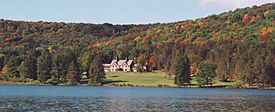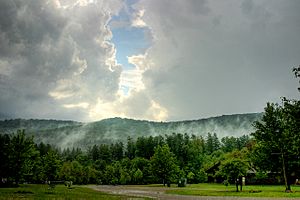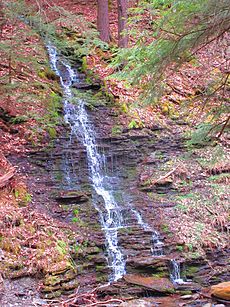Allegany State Park facts for kids
Quick facts for kids Allegany State Park |
|
|---|---|

The park's Red House Administration Building from across Red House Lake.
|
|
| Lua error in Module:Location_map at line 420: attempt to index field 'wikibase' (a nil value). | |
| Type | State park |
| Location | Cattaraugus County, New York |
| Area | 64,800 acres (262 km2) |
| Created | July 30, 1921 |
| Operated by | New York State Office of Parks, Recreation and Historic Preservation |
| Open | All year |
Allegany State Park is a huge park in western New York State. It's located in Cattaraugus County, right next to the Allegheny National Forest in Pennsylvania. People often call it "the wilderness playground of Western New York" because there's so much to do!
The park is split into two main parts: the Red House Area and the Quaker Run Area. It's known as a top "Amazing Spot" in the country. In 2024, the park was also a great place to see the total solar eclipse.
Contents
- Exploring Allegany State Park
- Park History: How it Began
- Getting Around: Park Roads
- Park Buildings
- Hiking Trails: Explore Nature
- Program Sites: Guided Adventures
- Cabin Trails: Cozy Stays
- Tent and Trailer Camping
- Group Camps: For Big Gatherings
- Beaches: Cool Off in the Water
- Park Maps
- Park Climate: Weather in Allegany
- Images for kids
Exploring Allegany State Park
Allegany State Park is a fantastic place for outdoor adventures. It has two main sections, each with its own cool features.
Red House Area: Fun by the Lake
The Red House Area is in the northeastern part of the park. Here you can find:
- Stone Tower and the Summit Fire Tower: Great spots for views.
- Red House Lake: Perfect for water activities.
- Bridal Falls: A beautiful waterfall.
- Art Roscoe Ski Area: A place for winter sports.
- Bike Trails: Five miles (8 km) of paved paths for cycling.
- Campsites: Over 130 places to set up camp.
This area also has the main office for the park.
Quaker Run Area: Wilderness Adventures
The Quaker Run Area is in the southwestern part of the park. Some of its highlights include:
- Quaker Lake: Another lovely lake.
- Mount Tuscarora Fire Tower: Offering more amazing views.
- Hiking Trails: Many paths to explore nature.
- Science Lake: A peaceful spot.
- Bear Caves and Thunder Rocks: Unique rock formations to discover.
- Quaker Amphitheater: A place for outdoor shows.
- Cain Hollow Campground: More great places to camp.
Park History: How it Began
Allegany State Park started a long time ago, on May 2, 1921. The state of New York decided to buy land to create this big park.
Early Days and Growth
The park was officially opened on July 30, 1921. Senator Albert T. Fancher was a key person in making the park happen. He's even called the "Father of Allegany State Park."
At first, people stayed in army tents. Then, the first permanent cabins were built in 1925. Funds from a special bond helped develop the Red House Area. This included building the Red House Administration Building and creating Red House Lake with a dam.
In 1926, Science Lake was built, offering the park's first official swimming spot. There was also a special school nearby, the Allegany School Of Natural History, where people could learn about nature.
Building the Park with the CCC
From 1933 to 1942, the Civilian Conservation Corps (CCC) helped a lot. These workers built roads, bridges, camping areas, and trails. They also worked on conservation projects like planting trees and improving wildlife habitats.
Over the years, the park kept growing. More lakes, winter cabins, and trails for hiking and snowmobiling were added. A ski area called Bova was built in the 1930s but closed in 1980. You can still enjoy cross-country skiing there today.
Old Dance Halls and Fun Times
In the past, the park had dance halls where people would gather for fun.
- The Old Quaker Dance Hall was a popular spot for live music and dancing, especially during the Great Depression. It was taken down in 2002 because it was very old.
- The Redhouse Dance Pavilion was by Redhouse Lake. It also hosted dances from the 1920s through the 1970s. This building was later used as a game room before being torn down in 1984.
Today, the Quaker side of the park has an amphitheater. It used to host a long-running music event called a hootenanny.
New Ireland Settlement
There's also a bit of history about a settlement called New Ireland. In the mid-1800s, Irish settlers came here after fleeing the Great Famine. The village is now part of Limestone, but you can still see ruins of the old village.
Fire Towers: Watching for Wildfires
To help prevent forest fires, three fire lookout towers were built.
- The Summit Fire Tower was finished in 1926 and is 66 feet (20 meters) tall.
- The Mt. Tuscarora Fire Tower is still standing near Quaker Lake.
- The Mt. Irvine Fire Tower was moved and rebuilt in Ellicottville.
These towers were used until 1971 when planes took over watching for fires.
Natural Gas Storage
Deep underground in the park, there's a large storage area for natural gas. This "Limestone Storage Pool" helps provide gas to the park and local businesses. The park has rules to protect it from new drilling.
Getting Around: Park Roads
The park has three main roads that connect the Red House and Quaker Run areas.
| Name | Length (miles) | From | To | Notes |
|---|---|---|---|---|
| ASP 1 | 14.4 | NY 951M in Salamanca | ASP 3 at the Quaker Run Area | Closed for snowmobiling in winter. |
| ASP 2 | 10.3 | I-86/NY17 (Exit 19) in Red House | ASP 3 near Bradford, PA | Main winter road between Red House and Quaker Run. |
| ASP 3 | 12 | NY280 in Cold Spring | Pennsylvania State Line | Main winter road between Red House and Quaker Run. |
Other Roads
There are also several smaller paved roads, like ASP Route 2A along Red House Lake, Quaker Lake Road, and Cain Hollow Road. Many dirt roads also lead to different parts of the park, though some are closed in winter.
Park Buildings
Allegany State Park has important buildings that help visitors and staff.
The Administration Building
This building in the Red House Area was built a long time ago in the Tudor style. It looks rustic but has been updated inside. It holds:
- The Red House Rental Offices
- The NYS Park Police Station
- The park's natural history museum
- The Red House Gift Shop
- The Red House Restaurant
It also has a cozy sitting room with a big window looking out over Red House Lake.
Old Quaker Store Museum
Opened in 1996, this museum teaches visitors about the park's history and nature. It's located in Salamanca, New York.
Hiking Trails: Explore Nature
Allegany State Park has 21 hiking trails for all skill levels, open all year.
Popular Trails
- Art Roscoe Ski Touring Area: These trails are groomed for cross-country skiing in winter.
- North Country Trail: A famous trail over 4,000 miles (6,400 km) long that passes through the park for 18 miles (29 km). It has four lean-tos for hikers to rest.
- Black Snake Mountain Trail: This trail touches the Pennsylvania state line. You can even find a marker where you can sit in two states at once!
- Tornado Trail: In the Quaker Area, this trail shows the path of a tornado from 1990. You can still see where it cut through the trees.
Bike Path
There's also a paved bike path around Red House Lake. It includes the Thomas E. Kelly Bridge, which is the only covered bridge in Western New York.
Program Sites: Guided Adventures
The park has 71 special "program sites." These are places where park naturalists lead guided walks and activities. For example, you might go on a tour of a beaver colony, hike to Bridal Falls, or explore the Bear Caves.
Cabin Trails: Cozy Stays
The park has many cabins for rent, including 150 that are open all year. They are grouped into "cabin trails" with dirt roads.
Red House Area Cabins
The Red House area generally has newer cabins. Some are one-room, while others have two, three, or even four rooms. Many have kitchenettes.
- Electricity and Refrigerators: Most Red House cabins have electricity and refrigerators.
- Toilets and Showers: All Red House cabin trails have central flush toilets and shower houses.
- Winter Rentals: All cabins in the Red House area are available year-round.
Quaker Area Cabins
The Quaker area also has a mix of cabin styles, from one-room to multi-room options.
- Electricity and Refrigerators: Most Quaker cabins have electricity and refrigerators, but some do not.
- Toilets and Showers: Central flush toilets are available on some cabin trails and in bathhouses. Showers are also available in bathhouses.
- Winter Rentals: Some Quaker cabins are available during the winter months.
Full Service Cottages
The park also offers 10 "full service" cottages, mostly in the Quaker Run Area. These are like small homes with bathrooms, showers, kitchens, and even bedding. The seven Fancher Cottages are named after Senator Albert T. Fancher. The Pitt Cottage in the Red House Area has a gas fireplace.
Tent and Trailer Camping
If you prefer camping in a tent or trailer, the park has three campgrounds with 424 sites.
- Red House Tent and Trailer Area: Located along Stoddard Creek, this campground has five loops. Some sites have electricity.
- Cain Hollow Camping Area: This campground is off Quaker Lake Road. It has four loops, many with electrical hookups. The bathhouses here are new and accessible. Cain Hollow is open from mid-May to mid-October.
- Diehl Tent and Trailer Trail: This area has 22 non-electric sites and also includes 8 cabins.
You can reserve campsites and cabins online through ReserveAmerica.com.
Group Camps: For Big Gatherings
The park has larger campsites called Group Camps, perfect for groups like Boy Scouts or church organizations. These camps usually have several cabins or dorms, a kitchen, dining hall, and bathrooms.
- Camp Allegany and Camp Turner are two large group camps. Camp Turner has been a summer camp for children since 1923.
The park is currently working to rebuild and improve some of these older group camps.
Beaches: Cool Off in the Water
Allegany State Park has two swimming beaches, perfect for cooling off on a hot day.
- Red House Lake Beach
- Quaker Lake Beach
Both beaches have lifeguards on duty from 11 AM to 7 PM. They also have diving platforms in 12-foot (3.7 m) deep water. You'll find bathrooms and snack bars at both locations.
Park Maps
A new map and brochure for Allegany State Park were created in 2010 to help visitors find their way around.
Park Climate: Weather in Allegany
Allegany State Park has a climate with warm summers. The hottest temperature ever recorded here was 101°F (38°C) on July 9, 1936. The coldest was -35°F (-37°C) on February 9, 1934.
| Climate data for Allegany State Park, New York, 1991–2020 normals, extremes 1924–present | |||||||||||||
|---|---|---|---|---|---|---|---|---|---|---|---|---|---|
| Month | Jan | Feb | Mar | Apr | May | Jun | Jul | Aug | Sep | Oct | Nov | Dec | Year |
| Record high °F (°C) | 72 (22) |
72 (22) |
82 (28) |
89 (32) |
90 (32) |
94 (34) |
101 (38) |
97 (36) |
97 (36) |
90 (32) |
81 (27) |
70 (21) |
101 (38) |
| Mean maximum °F (°C) | 53.7 (12.1) |
53.7 (12.1) |
65.3 (18.5) |
78.3 (25.7) |
84.4 (29.1) |
86.6 (30.3) |
87.2 (30.7) |
85.8 (29.9) |
83.2 (28.4) |
75.4 (24.1) |
66.6 (19.2) |
55.9 (13.3) |
89.1 (31.7) |
| Mean daily maximum °F (°C) | 31.2 (−0.4) |
33.3 (0.7) |
41.9 (5.5) |
55.6 (13.1) |
67.6 (19.8) |
75.3 (24.1) |
78.7 (25.9) |
77.0 (25.0) |
70.4 (21.3) |
58.6 (14.8) |
46.4 (8.0) |
35.8 (2.1) |
56.0 (13.3) |
| Daily mean °F (°C) | 23.3 (−4.8) |
24.4 (−4.2) |
31.8 (−0.1) |
43.9 (6.6) |
55.3 (12.9) |
63.7 (17.6) |
67.4 (19.7) |
66.1 (18.9) |
59.5 (15.3) |
48.5 (9.2) |
38.3 (3.5) |
29.0 (−1.7) |
45.9 (7.7) |
| Mean daily minimum °F (°C) | 15.3 (−9.3) |
15.4 (−9.2) |
21.7 (−5.7) |
32.2 (0.1) |
43.0 (6.1) |
52.1 (11.2) |
56.2 (13.4) |
55.1 (12.8) |
48.7 (9.3) |
38.4 (3.6) |
30.1 (−1.1) |
22.2 (−5.4) |
35.9 (2.2) |
| Mean minimum °F (°C) | −7.1 (−21.7) |
−5.0 (−20.6) |
0.0 (−17.8) |
19.7 (−6.8) |
28.5 (−1.9) |
36.8 (2.7) |
45.0 (7.2) |
43.7 (6.5) |
35.0 (1.7) |
25.4 (−3.7) |
15.1 (−9.4) |
5.0 (−15.0) |
−10.3 (−23.5) |
| Record low °F (°C) | −27 (−33) |
−35 (−37) |
−18 (−28) |
7 (−14) |
18 (−8) |
24 (−4) |
25 (−4) |
28 (−2) |
20 (−7) |
12 (−11) |
−4 (−20) |
−22 (−30) |
−35 (−37) |
| Average precipitation inches (mm) | 3.46 (88) |
2.37 (60) |
2.88 (73) |
3.99 (101) |
4.03 (102) |
4.61 (117) |
5.10 (130) |
4.31 (109) |
4.19 (106) |
4.27 (108) |
3.76 (96) |
3.67 (93) |
46.64 (1,183) |
| Average snowfall inches (cm) | 21.0 (53) |
18.2 (46) |
12.7 (32) |
2.8 (7.1) |
0.0 (0.0) |
0.0 (0.0) |
0.0 (0.0) |
0.0 (0.0) |
0.0 (0.0) |
0.2 (0.51) |
7.4 (19) |
20.8 (53) |
83.1 (210.61) |
| Average precipitation days (≥ 0.01 in) | 17.5 | 14.0 | 12.4 | 13.3 | 12.8 | 11.9 | 11.7 | 11.2 | 10.9 | 13.7 | 13.3 | 16.1 | 158.8 |
| Average snowy days (≥ 0.1 in) | 10.2 | 8.3 | 4.8 | 1.4 | 0.0 | 0.0 | 0.0 | 0.0 | 0.0 | 0.1 | 3.0 | 7.5 | 35.3 |
| Source 1: NOAA | |||||||||||||
| Source 2: National Weather Service | |||||||||||||
Images for kids







